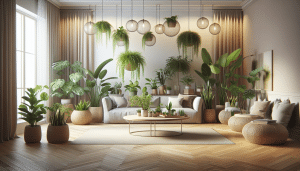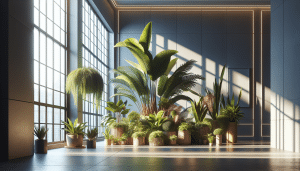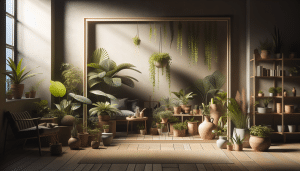Unexpected Ways You Can Transform Small Gardens
Daniel Fisher September 21, 2025
Unlock practical ideas to elevate small gardens into inviting, functional outdoor retreats. Discover design strategies, container choices, vertical solutions, and creative touches that maximize limited space and boost curb appeal for any home.
Creative Layouts for Compact Outdoor Spaces
Small gardens have surprising potential. The right layout can create an illusion of depth, turning even a tiny backyard into a spacious sanctuary. Designers often recommend using curved pathways rather than straight lines. These gently winding walks are visually appealing and draw the eye further into the garden. Adding focal points—such as a birdbath or a vibrant planter—encourages visitors to explore. Layering plants according to their height builds depth and texture, subtly expanding the space and providing a lush look that’s easy to care for in compact areas.
Raised garden beds add dimension and practicality to small garden designs. Beds can be constructed from wood, stone, or even recycled materials, providing a structured area for anything from perennials to kitchen herbs. Raised beds improve drainage, which is important for many plant types, and keep pathways clear and tidy. Enclosing your beds with gravel or bark chips creates clear divisions between planting and seating areas, giving each element its own defined space. Mulching not only conserves moisture but also helps reduce the need for frequent weeding, making gardening less burdensome.
Visual tricks are key when working with limited outdoor space. Using mirrors safely in garden designs adds light and gives the impression of extra space. Mirrors should be placed to reflect leafy areas, enhancing greenery without clutter. Opting for diagonal placement of paving stones and decorative items pulls the gaze across the area, making a narrow plot look wider. Choosing a neutral palette for hardscaping and furniture sets a soothing background for the plants to pop without overwhelming the overall effect. These strategies ensure that every square foot feels intentional and cared for.
Choosing Plants for Versatility and Beauty
Plant selection plays a huge role in transforming a small garden. Opt for species that serve more than one purpose, like ornamental grasses that offer year-round texture and privacy. Dwarf fruit trees deliver attractive blossoms each spring and delicious yields in summer and fall, all while staying manageable in scale. Shrubs like boxwood add evergreen structure and can be shaped to suit tight spaces. Utilizing native plants makes gardens easier to maintain and far more resilient to local pests and weather swings. These hardy varieties generally require less water and fertilizer, reducing maintenance and supporting local biodiversity (https://extension.psu.edu/right-plant-right-place-keys-to-successful-gardening).
Flowering annuals and perennials add constant bursts of color. Consider planting in succession to guarantee blooms from early spring through frost. Layering bulbs beneath perennials leads to staggered flowering, which maintains garden energy across the seasons. Pollinator-friendly plants like lavender and salvia provide scent, motion, and ecological benefit, attracting bees and butterflies. Interspersing edible plants, such as lettuce or strawberries, within the ornamental beds adds visual interest and encourages daily interaction with the garden.
Don’t overlook foliage. Variegated and evergreen leaves are as important for texture and year-round appeal as flowers. Hostas, ferns, and heucheras dazzle in shady corners, while silvery artemisia or lamb’s ear can brighten dry, sunny stretches. Mixing plant heights and leaf shapes brings the garden to life and invites exploration. Growing herbs, succulents, and colorful seasonal flowers in containers—placed either on stairs or at different levels—provides flexibility and a fresh look week after week.
Maximizing Vertical Space Effectively
In small gardens, vertical gardening becomes a powerful solution for increasing production and visual impact. Simple trellises or garden screens turn fences and walls into living tapestries. Climbing plants, such as clematis or star jasmine, introduce lush greenery without sacrificing precious ground space. Using stacked planters, wall-mounted pockets, or even hanging baskets adds vertical layers and encourages creative planting combinations. These structures can be moved or refreshed seasonally, making it easy to experiment or adapt as preferences change.
Lattice panels, storm fencing, and modular wall systems are widely available and inexpensive options for vertical plant support. Fast-growing annual vines like sweet peas or morning glories can be grown for a season of quick coverage, while more permanent choices like ivy or honeysuckle anchor the garden long-term. For those who love fresh herbs or vegetables, vertical wall gardens offer endless possibility. Lettuce, spinach, and strawberries thrive in wall planters, often yielding better results than in overcrowded border beds due to improved air circulation and targeted watering systems (https://www.extension.purdue.edu/extmedia/HO/HO-260-W.pdf).
Integrating shelving, hanging lanterns, or small decorative artwork on outdoor walls personalizes the space and extends the home’s style. Sturdy hooks or grids can hold everything from planters to outdoor kitchen tools, maximizing the function of seldom-used surfaces. Vertical gardening isn’t only about plants—the combination of living green, décor, and practical storage transforms even the narrowest side yard or balcony into a vibrant living area that feels much larger than it is in reality.
Clever Container Gardening Tactics
The right container strategy turns small patios, balconies, or pockets of available space into lush, productive gardens. Containers provide flexibility and offer an easy way to experiment with color, texture, and seasonal themes. It’s advisable to select large, lightweight containers with good drainage. Multipurpose planters, such as those with self-watering features, help minimize maintenance and maintain healthier plants. Clustering containers in odd numbers and varying their heights adds dimension and prevents the area from feeling static or cramped.
Experimenting with edible and ornamental combinations has grown in popularity for container gardens. Herbs, compact tomatoes, chili peppers, and dwarf citrus plants thrive alongside bright marigolds, trailing lobelia, or petunias. Many container-friendly hybrids have been bred specifically for small-space adaptability. Regularly rotating container positions allows for optimal sunlight and prevents uneven growth. For shaded balconies, use shade-tolerant ferns, begonias, and impatiens to achieve a lush look with less sun exposure.
Incorporating recycled or upcycled materials makes container gardening both eco-friendly and cost-effective. Old buckets, wine boxes, or even sturdy tote bags can be used with simple drainage modifications. Tiered stands or shelves make use of vertical area and ensure every plant is accessible. With a bit of planning, containers can transform an uninspiring porch or hardscape into a welcoming display, and plants can be brought indoors seasonally for year-round enjoyment and care (https://hgic.clemson.edu/factsheet/container-gardening).
Low-Maintenance Upgrades That Add Value
Small gardens don’t require high maintenance to impress. Hardscaping—such as stone pathways, benches, or water features—reduces mowing and weeding needs. Composite decking or gravel patios give the look of luxury without yearly refinishing. Solar-powered lighting is easy to install and provides soft illumination for evening enjoyment, all with minimal energy costs. Adding a small water feature or fountain introduces gentle sound, distracts from street noise, and can attract birds, increasing the sense of a private retreat.
Automated irrigation or drip systems keep maintenance requirements low and ensure consistent watering, even when busy schedules or travel interfere with gardening routines. These systems are compact and efficient, and can usually be set up in an afternoon. Mulching with bark, pebbles, or groundcover plants not only retains moisture but keeps borders looking polished. Weatherproof garden art crafted from metal or stone stands up to the elements and delivers personality year-round without the need for repainting or repairs.
Smart upgrades add tangible value for homeowners. Well-maintained, landscaped outdoor areas are repeatedly shown to increase property appeal and resale value, especially for urban dwellings or townhouses with limited outdoor space (https://www.nar.realtor/research-and-statistics/research-reports/remodeling-impact). Keeping updates low-maintenance ensures your garden remains welcoming and stress-free, while still delivering a sense of personal pride every time you step outside. A tidy, inviting outdoor area is always a selling point.
Personalizing with Art, Lighting, and Accessories
Personal touches turn a functional small garden into an inviting extension of your home. Integrated seating—like built-in benches or simple hammock hooks—provides cozy gathering spots. Outdoor rugs, pillows, and textiles designed for weather resistance bring color and comfort to patios and decks. Decorative screens, trellises, or mosaics double as privacy barriers in close-knit communities, and they can be customized to reflect personal taste or style.
Outdoor lighting extends usability well into evenings. String lights, solar-powered lanterns, and spotlights all highlight key features or pathways for added safety and ambiance. Lighting the base of trees or large pots draws attention upward, making small gardens feel taller and brighter. Selecting colors and materials that reflect those indoors further blurs the line between home and garden, giving continuity and an open, expansive feeling to both.
Artful touches make a small space memorable. Weatherproof sculptures, birdhouses, or even painted stones give personality and spark conversation. Wind chimes add gentle sound, while mirrors or glass art catch light and movement. Regularly rotating or updating accessories keeps the space feeling fresh and responsive to the seasons, ensuring your small garden always feels just right for relaxation or entertaining. With thoughtful arrangement, even the tiniest outdoor area becomes a place to linger.
References
1. Penn State Extension. (n.d.). Right Plant, Right Place: Keys to Successful Gardening. Retrieved from https://extension.psu.edu/right-plant-right-place-keys-to-successful-gardening
2. Purdue University Extension. (n.d.). Vertical Vegetable Gardening in Small Spaces. Retrieved from https://www.extension.purdue.edu/extmedia/HO/HO-260-W.pdf
3. Clemson University Extension. (n.d.). Container Gardening. Retrieved from https://hgic.clemson.edu/factsheet/container-gardening
4. The Royal Horticultural Society. (n.d.). Small Garden Ideas and Advice. Retrieved from https://www.rhs.org.uk/garden-design/small-space-gardens
5. U.S. Department of Agriculture. (n.d.). Urban Agriculture Tool Kit. Retrieved from https://www.usda.gov/sites/default/files/documents/urban-agriculture-toolkit.pdf
6. National Association of Realtors. (n.d.). Remodeling Impact Report: Outdoor Features. Retrieved from https://www.nar.realtor/research-and-statistics/research-reports/remodeling-impact








